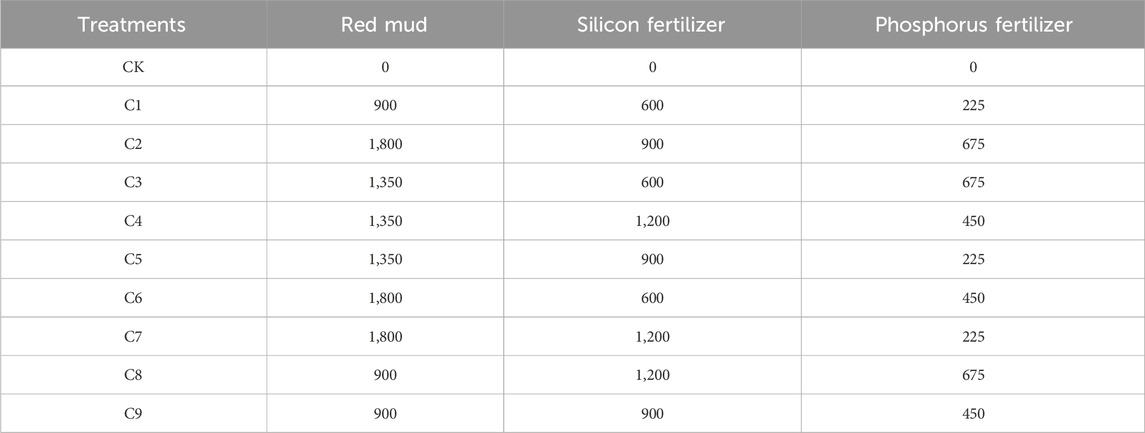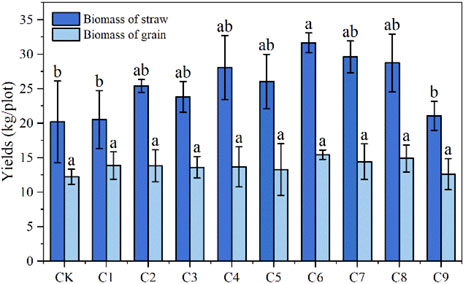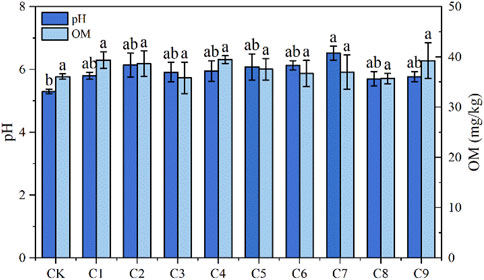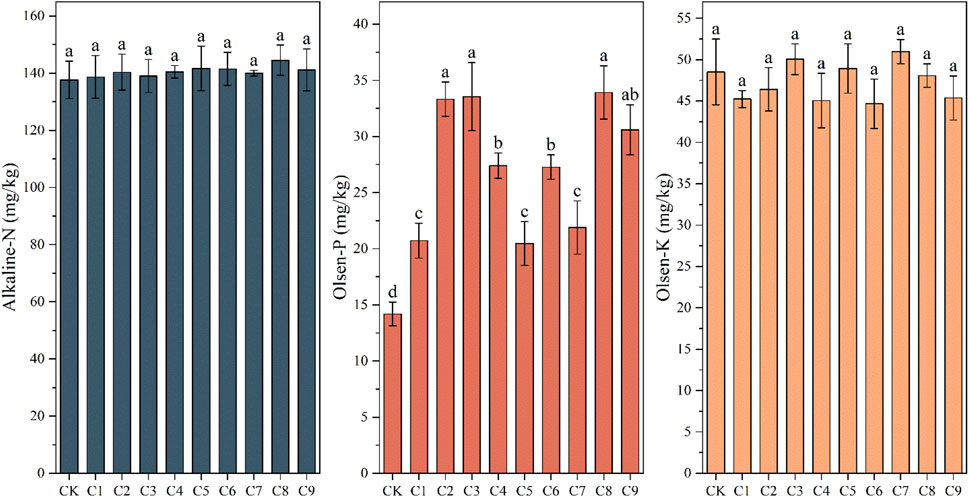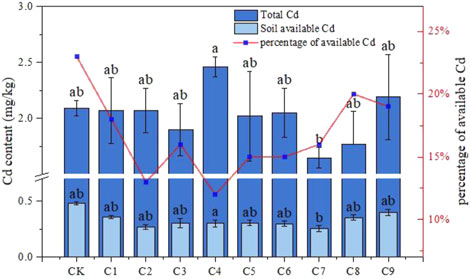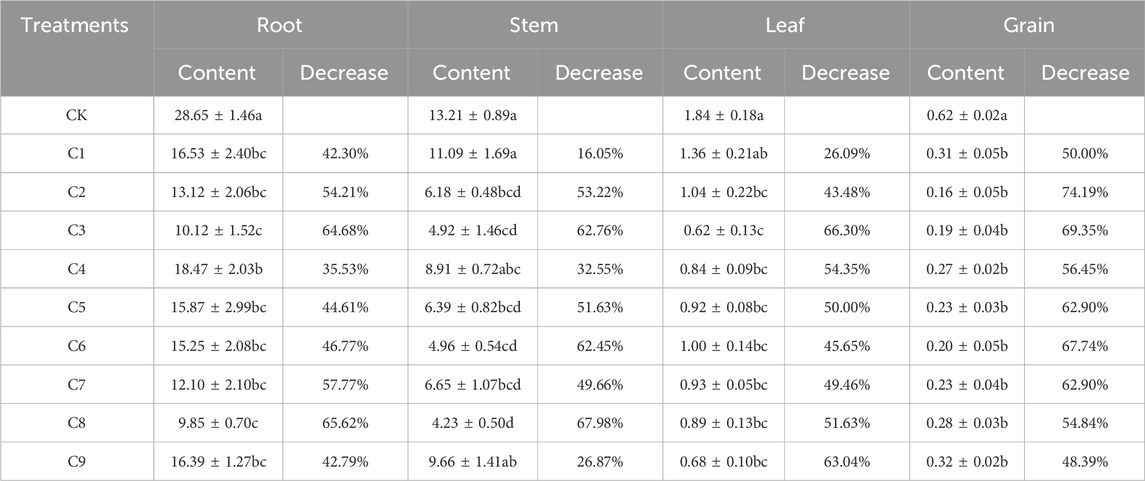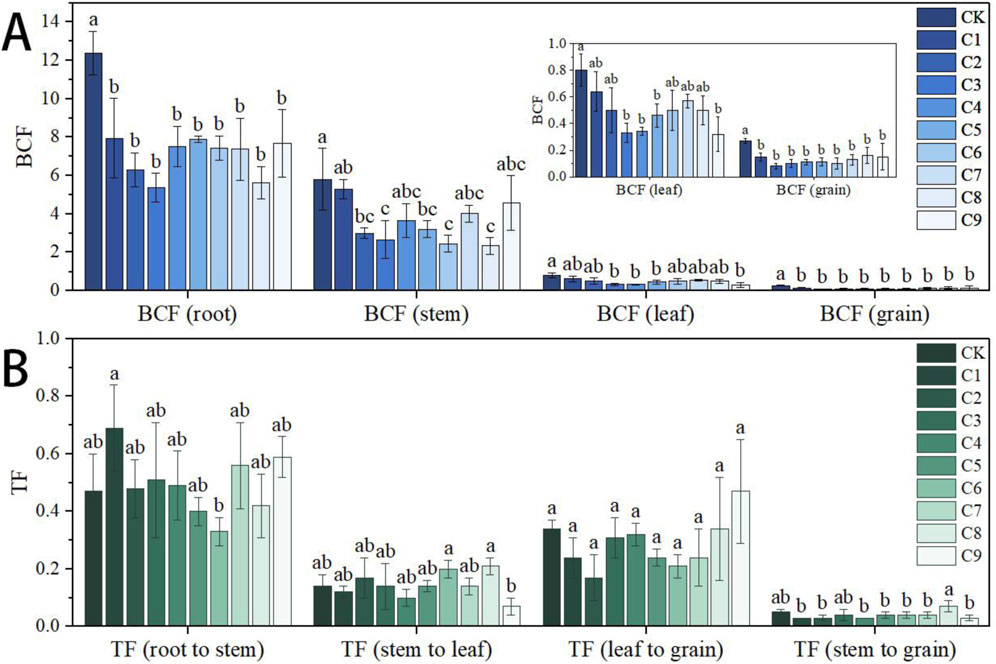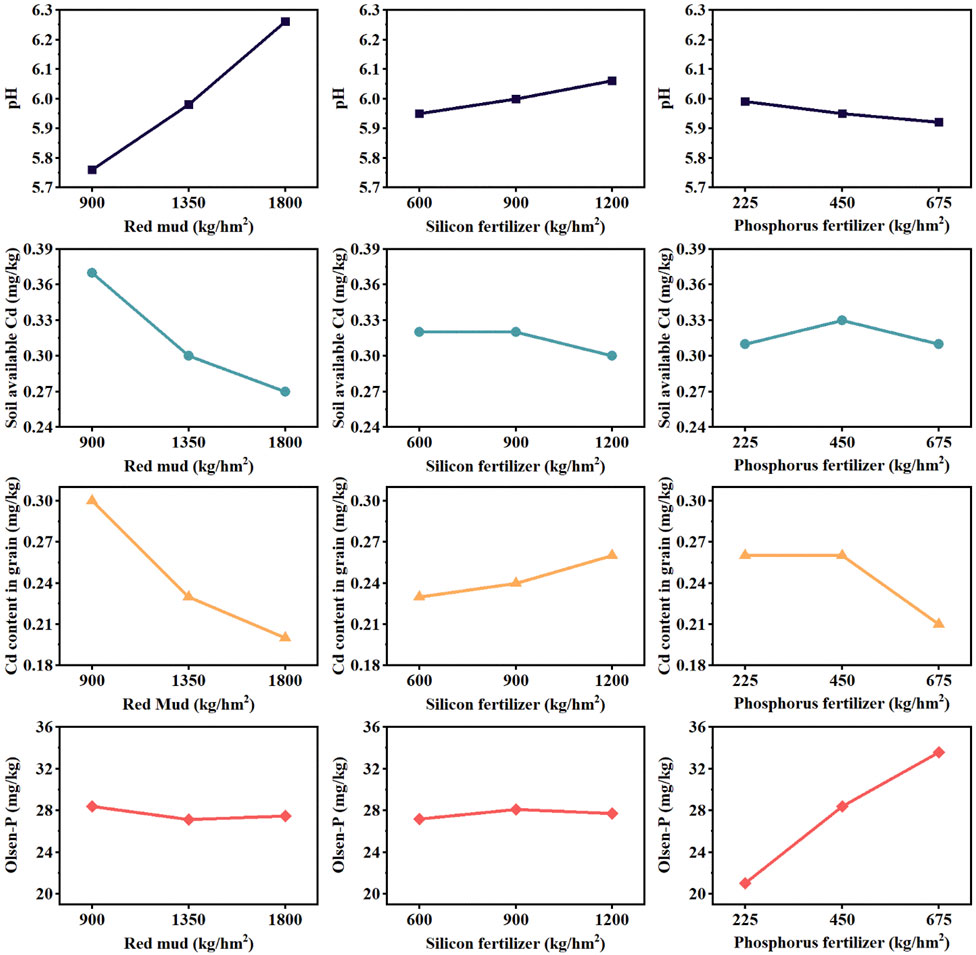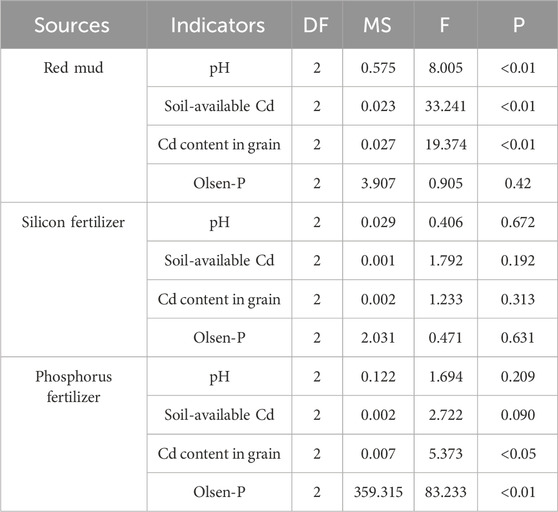- 1College of Environment and Ecology, Hunan Agricultural University, Changsha, China
- 2Bureau of Agriculture and Rural Affairs of Cili County, Zhangjiajie, China
To achieve safe production of severe cadmium (Cd)-contaminated paddy fields, the effects of a combination of red mud, silicon fertilizer, and phosphorus fertilizer on the absorption, transportation, and accumulation of Cd in rice were studied by a field plot orthogonal experiment. The results showed that soil pH, biomass of straw, and grain increased after applying the combined soil amendments. Compared with the control (CK), soil-available Cd decreased by 16.90%–47.09%. Cd content decreased by 42.30%–65.62% in roots, 16.05%–67.98% in stems, 26.09%–66.30% in leaves, and 48.39%–74.19% in grain. Variance and range analysis showed the effect of the three amendments on Cd reduction in grain was in descending order: red mud > silicon fertilizer > phosphate fertilizer. The optimal combination of soil amendments to control Cd pollution was 1,800 kg/ha red mud, 600 kg/ha silicon fertilizer, and 675 kg/ha phosphorus fertilizer. Results showed that safe production from severely Cd-contaminated paddy fields could be achieved by applying a combination of soil amendments and provided a method for remediating a severely Cd-contaminated paddy field.
1 Introduction
Cadmium (Cd), a toxic pollutant, has been increasingly released into soil with rapid urbanization and industrialization and is widely used in agricultural inputs, which poses a severe threat to human health (Zhao et al., 2017a; 2017b; Yu et al., 2022). Rice (Oryza sativa L.) is a naturally Cd-loving plant that absorbs and accumulates Cd from paddy fields, resulting in Cd contamination of the rice grain. Large quantities of Cd in food are absorbed and accumulated in human bodies and can cause health issues such as fractures, mutagenesis, carcinogenesis, and teratogenesis (Song et al., 2003; Zhong et al., 2021). Rice is the most common food worldwide and feeds more than half of the world’s population (Fukagawa and Ziska, 2019; Nawaz et al., 2022; Tang et al., 2022), making rice quality a most important issue for food security and global health. Thus, there is an urgent and critical strategic need to control Cd pollution in rice.
In order to reduce the effect of Cd on human health, many remediation technologies such as water management (Zhong et al., 2021), planting low-Cd-affinity rice varieties (Zhao et al., 2015), microbial remediation (Mao et al., 2022), and amendment remediation (Deng et al., 2020) have been created and deployed to decrease Cd uptake and accumulation in rice grain from Cd-contaminated paddy fields. Of them, in situ chemical amendment remediation methods have been proven to be the most economical and convenient method of controlling Cd contamination in rice because of their low cost, simple operation, high efficiency, and large-scale applicability (Li et al., 2018; Xu et al., 2021). Because of large population and limited amount of cultivated land, Cd-contaminated paddy fields must be remediated during the crop production seasons in China (Wang et al., 2019; Zou et al., 2021).
Red mud, a byproduct of aluminum production (Zhu et al., 2020; Guo et al., 2022; Huang et al., 2022), has been proven to be an inexpensive and effective chemical amendment for in situ remediation of Cd-contaminated paddy fields (Lombi et al., 2002; Garau et al., 2007). Many studies found that the red mud mechanism was a reduction of soil Cd activity by improving soil pH (Li et al., 2018; Meng et al., 2022; Zhou et al., 2024). Rice is a typical Si-loving plant, and application of silicon fertilizer has also been confirmed to be highly efficient at controlling Cd pollution in rice in pot and field experiments (Rehman et al., 2019; Cai et al., 2020; Hussain et al., 2020; Xiao et al., 2021). Numerous studies have shown that the mechanism of silicon fertilizer was a reduction of soil Cd availability (Rehman et al., 2019; Zhao et al., 2020a), and Si inhibited the expressions of Cd transporter genes: OsNramp5 and OsHMA2 (Feng Shao et al., 2017). Phosphate fertilizer, such as alkaline calcium-magnesia-phosphate, has been proven to effectively to reduce Cd content in rice (Seshadri et al., 2017; 2016; Zhao et al., 2020b; Wu et al., 2023), and studies also shown the mechanism of phosphate fertilizer for controlling Cd pollution in rice was reduction of soil Cd availability (Seshadri et al., 2016; 2017).
Although a single application of red mud, silicon fertilizer, and phosphorus fertilizer had been proved efficiently to control Cd pollution in rice of mild and moderate Cd-contaminated paddy fields (Meng et al., 2022; Rehman et al., 2019; Zhao et al., 2020b), their effectiveness was limited in severely Cd-contaminated paddy fields, and previous studies had not been able to achieve safe production of Cd-contaminated paddy fields (Wang et al., 2021; Chao et al., 2022). Combined soil amendments were more effective and stable than any single component (Pei et al., 2021; Jiang et al., 2022). Based on the effects and mechanisms of the three amendments, we think that their combination could result in better remediation of severely Cd-contaminated paddy fields.
In this study, the effects of the combination of red mud, silicon fertilizer, and phosphate fertilizer on Cd accumulation in rice and its mechanism were studied by field plot orthogonal experiments to screen some low-cost, high-efficiency, stable, and universal combined soil amendments to achieve safe production in Cd-contaminated paddy fields, especially for acidic severely Cd-contaminated paddy fields.
2 Materials and methods
2.1 Field experimental site
The field experiment was implemented in Liuyang City, Hunan Province, with a latitude and longitude of 28°13′27.49″N and 113°32′35.65″E, respectively. The soil type in the study area is acidic red soil, and the basic physical and chemical properties of paddy fields (0–20 cm) in the study site are shown in Table 1. The soil total Cd content was 1.98 mg/kg, approximately five times higher than the Soil Environmental Quality Risk Control Standard for Soil Contamination of Agricultural Land (GB 15618-2018) (0.40 mg/kg) (MEEPRC and SAMR, 2018). Thus, the field was considered a severely Cd-contaminated paddy field. The local climate is a subtropical monsoon climate type with an annual temperature of 16.8–17.5°C and a precipitation of 1,400–1,700 mm on average.
2.2 Experimental materials
Red mud was purchased from Changxing Industrial Co., Ltd., Henan Province. It contains large amounts of Fe2O3 and Al2O3 and smaller amounts of SiO2, TiO2, CaO, and Na2O. The pH value and content of organic matter of the red mud are 11.25 g/kg and 5.00 g/kg, respectively, and contents of Cu, Zn, Pb, Cd, and As in the red mud are 27.58 mg/kg, 31.13 mg/kg, 36.75 mg/kg, 0.13 mg/kg, and 11 mg/kg, respectively, lower than the limit (Pb < 200 mg/kg, Cd < 10 mg/kg, As < 50 mg/kg) of the standard: Limitation Requirements of Toxic and Harmful Substance in Fertilizers (GB 38400-2019) (SAMR and SAPRC, 2019). Silicon fertilizer was purchased from Mingyuan Chemical Raw Materials Co., Ltd., Zhengzhou, Henan Province. Its content of SiO2 is more than 26%. Phosphate fertilizer (Ca(H2PO4)2·H2O) was purchased from Tongguanshan Chemical Co., Ltd., Tongling, Anhui Province, and the P and Ca contents are more than 22% and 18%, respectively.
The test rice variety is Yuzhenxiang, which is known for its high Cd accumulation capacity and was specifically selected to evaluate the Cd uptake performance under different soil amendment treatments. It was purchased from the Hunan Rice Research Institute and proved to be suitable for double rice cropping in areas with mild rice blast in Hunan Province. The growth period of the test rice variety was 114 days on average.
2.3 Field experimental design and sample collection
In this study, a three-factor, three-level orthogonal experiment was conducted in a field plot. The specific factors and levels were red mud (900 kg/ha, 1,350 kg/ha, and 1,800 kg/ha), silicon fertilizer (600 kg/ha, 900 kg/ha, and 1,200 kg/ha) and phosphorus fertilizer (225 kg/ha, 450 kg/ha, and 675 kg/ha). Ten treatments, including CK and CK, were employed as a control without any amendments. The composition of each treatment is shown in Table 2, and each treatment was repeated three times. The area of each plot was 20 m2, and the plots were separated by ridges covered with a plastic membrane. Combined soil amendments were applied as base fertilizers and mixed by a rototiller 1 week prior to rice transplantation. In order to prevent mutual interference, separate irrigation and drainage were applied at all plots. Field management was taken according to local habits, including irrigation, weeding, fertilization, and pest control.
One week before the trial, soil samples were collected from the tested field with the five-point sampling method. At harvest, rice and soil samples were collected separately from each plot with the five-point sampling method. Rice samples were washed with tap water followed by ultrapure water, and divided into four organs: root, stem, leaf, and grain. All rice samples were put into brown-paper envelopes, dried at 70°C to a constant weight, followed by 105°C for 1 h, and then ground into powder. Soil samples were ground and sieved by nylon mesh (0.15 mm) after being air-dried in an indoor ventilated room and placed in a desiccator in a sealed bag.
2.4 Sample analysis
After rice was harvested in the field, a threshing machine was used to separate the rice straw and grain. The biomass of the straw and grain was then weighed separately using an electronic scale. Soil pH was determined by pH meter PHS-3C (Leici Instrument, China) with a soil-to-water ratio of 1:2.5 (w/v) (Yang et al., 2008). Soil cation exchange capacity (CEC) and organic matter (OM) were measured using the barium chloride and sulfuric acid forced exchange method, respectively. Alkaline-N, Olsen-P, and Olsen-K in soil were analyzed by soil agrochemical analysis and environmental monitoring (Yang et al., 2008). Soil and rice samples were digested by mixed acids (HCl-HNO3-HClO4 for soil and HNO3-HClO4 for rice organs) and filtered after diluting to the mark. The Cd content in the solution was measured by inductively coupled plasma optical emission spectroscopy (ICP-OES) (PerkinElmer, United States) for soil and flame atomic spectroscopy (AA-240FS) (Varian, United States) for rice organs (Bao, 2000). The content of the soil-available Cd was measured by ICP-OES (PerkinElmer, United States) after extraction by 0.01 mol/L CaCl2 with a soil-to-solution ratio of 1:10 (w/v) (Bao, 2000).
2.5 Statistical data analysis
Means and standard deviations were calculated using MS Excel 2019. Range analysis, variance analysis of the orthogonal experiments, and one-way analysis of variance (ANOVA) were conducted using SPSS 24. Significant differences between treatments were detected with Tukey’s highly significant differences (HSD) test (P < 0.05) and marked by different lowercase letters. The Pearson correlation coefficient was analyzed by SPSS 24 and used to determine the correlation between the plant Cd content and various soil indicators. All figures were plotted using Origin 2024.
The bioconcentration factor (BCF) was calculated using Equation 1 to represent the accumulation of Cd in rice organs relative to total Cd content in soil.
where C1 (mg/kg) is Cd content in different organs of rice, and C2 (mg/kg) is the total Cd content of soil.
The translocation factor (TF) was calculated using Equation 2 to represent the transport characteristics of Cd in different organs of rice.
where C3 (mg/kg) is Cd content in the preceding organ of the rice, and C4 (mg/kg) is Cd content in the succeeding organ of the rice.
3 Results
3.1 Biomass of straw and grain
Compared with CK, the biomass of straw increased by 1.78%–56.92% after applying the combined soil amendments, but no significant increase was found (P > 0.05) except in C6. The biomass of the grain increased by 3.19%–26.06% after applying the combined soil amendments. The highest increase in biomass of grain was also in C6 (Figure 1). However, no significant increase was found between all treatments and the CK (P > 0.05).
3.2 Soil basic characteristics
Compared with the CK, soil pH increased by 7.55%–23.02% after applying the combined soil amendments, but no significant increase was found (P > 0.05) except in C7 (Figure 2). Soil OM changed −0.67% to 9.33% compared with the CK, and all treatments showed a slight increase except for C3 and C8. No significant difference was found between all treatments and the CK (P > 0.05) (Figure 2).
Alkaline-N, Olsen-P, and Olsen-K are significant factors of soil, and thus, the levels of these contents are the key indicators to measure soil fertility. Compared with the CK, the contents of alkaline-N and Olsen-K were maintained at the same level, but the content of Olsen-P increased 6.27–19.73 mg/kg after application of the combined soil amendments. No significant difference was found between all treatments and the CK in terms of Olsen-K and alkaline-N (P > 0.05), but significant differences were found between all treatments and the CK in terms of Olsen-P (P < 0.05) (Figure 3).
3.3 Soil total Cd and available Cd
After applying the combined soil amendments, the total soil Cd of all treatments was maintained at the same level, and no significant difference was found between all treatments and CK (P > 0.05). The content of soil-available Cd decreased by 16.90%–47.09% compared with the CK, and significant decreases were detected for all treatments (P < 0.05), except for C9 (Figure 4). The content of soil-available Cd of C7 was 0.25 mg/kg, which was the greatest decrease among all treatments. The percentage of available Cd in all treatments decreased compared with the CK. This is to say, application of the combined soil amendments could reduce the content of soil-available Cd and decrease its proportion of the soil total Cd.
3.4 Content of Cd in rice organs
After applying the combined soil amendments, the contents of Cd in different rice organs (root, stem, leaf, and grain) decreased by different magnitudes (Table 3). Compared with the CK, the contents of Cd in root, stem, leaf, and grain decreased by 35.53%–65.62%, 16.05%–67.98%, 26.09%–66.30%, and 48.39%–74.19%, respectively. Significant decreases were detected for treatments (P < 0.05) except for C1, C4, and C9 of the stem and C1 of the leaf. Of all the treatments, only the Cd contents in grain of C2 and C3 were lower than the limit (Cd < 0.20 mg/kg in grain) of the standard: National Food Safety Standard–Maximum Levels of Contaminants in Foods (GB 2762-2022) (SAMR and SAPRC, 2022), at 0.16 mg/kg and 0.19 mg/kg, respectively.
3.5 BCF and TF
After application of the combined soil amendments, the BCF values of Cd in root, stem, leaf, and grain were found to decrease in different magnitudes in the descending order of root, stem, leaf, and grain. All treatments resulted in significant decreases of BCF of Cd in rice root and grain compared with the CK, while significant decreases were only found for C2, C3, C5, C6, and C8 in the stem and for C3, C4, C5, and C9 in the leaf (P < 0.05) (Figure 5A).
TF values were highest for root to stem, followed by, in descending order, leaf to grain, stem to leaf, and stem to grain (Figure 5B). Compared with the CK, TF (root to stem) increased for C1, C2, C3, C4, C7, and C9 and decreased for C5, C6, and C8. TF (stem to leaf) increased for C2, C6, and C8, decreased for C1, C4, and C9, and had no change for C3, C5, and C7. TF (leaf to grain) decreased for all treatments except C8, which was higher than the CK. TF (stem to grain) decreased for all treatments except C8, which was higher than the CK. No significant difference was found in TF values, including TF (root to stem), TF (stem to leaf), TF (leaf to grain), and TF (stem to grain) of all treatments compared with the CK (P > 0.05) (Figure 5B).
3.6 Orthogonal analysis
Four indicators with significant impact after application of the combined soil amendments were selected for range analysis to assess the effects of amendment application levels on pH, soil-available Cd, Cd content in grain, and Olsen-P. The results of the range analysis showed that pH increased with increased application levels of red mud and silicon fertilizer but decreased with increased application levels of phosphate fertilizer; among these, red mud had the most significant effect on pH, while the other two had smaller impacts. Soil-available Cd decreased with increased application levels of red mud and silicon fertilizer, but initially increased and then decreased with increasing phosphate fertilizer levels. Red mud application had the most significant effect on soil-available Cd. Cd content in grain decreased with increasing application levels of red mud and phosphate fertilizer but increased with increased application levels of silicon fertilizer. Red mud had the most significant effect on Cd content in grain, followed by phosphate fertilizer, and then silicon fertilizer. Olsen-P increased with the increased application of phosphate fertilizer, while changes in red mud and silicon fertilizer application levels had little effect on Olsen-P (Figure 6).
Range analysis provides a direct assessment of the magnitude of the influence of the application levels of the three amendments on the four indicators, while variance analysis evaluates the statistical significance of these application levels’ effects on the four indicators. The results of variance analysis showed that red mud had the most significant effect on soil pH, soil-available Cd, and Cd content in grain (P < 0.01); phosphorus fertilizer had most significant effect on Olsen-P (P < 0.01) and significant effect on Cd content in grain (P < 0.05); and the silicon fertilizer had no significant effect on the four indicators (P > 0.05) (Table 4). The results of the variance analysis are consistent with range analysis, indicating that as the application levels of red mud increased, soil pH increased significantly (P < 0.01), and soil-available Cd and Cd content in grain decreased significantly (P < 0.01). Similarly, as the application levels of phosphate fertilizer increased, Cd content in grain decreased significantly (P < 0.05), while Olsen-P increased significantly (P < 0.01).
3.7 Correlation analysis
In terms of pH, the most significant positive correlation was detected between pH and OM (P < 0.01) (Figure 7A); the most significant negative correlations were detected between pH and soil-available Cd, pH and Cd content in root, and pH and Cd content in grain (P < 0.01) (Figure 7B). This may be related to the presence of a certain amount of OM in the amendments and the changes induced after their application. In terms of soil-available CD, the most significant positive correlations were detected between soil-available Cd and Cd content in root and soil-available Cd and Cd content in grain (P < 0.01) (Figure 7C). In terms of Cd content in the root, the most significant positive correlations were detected between Cd content in the root and Cd content in the stem, Cd content in the leaf, and Cd content in the grain (P < 0.01) (Figure 7D). This is because red mud is a highly alkaline substance that increases the soil pH, causing bioavailable Cd to convert to other non-bioavailable forms. The result of correlation analysis indicates that the mechanism of the combined soil amendments controlling Cd pollution in rice was significantly decreased soil-available Cd, which was caused by an increase in the soil pH and thereby decreasing the transfer of Cd from the soil to rice.
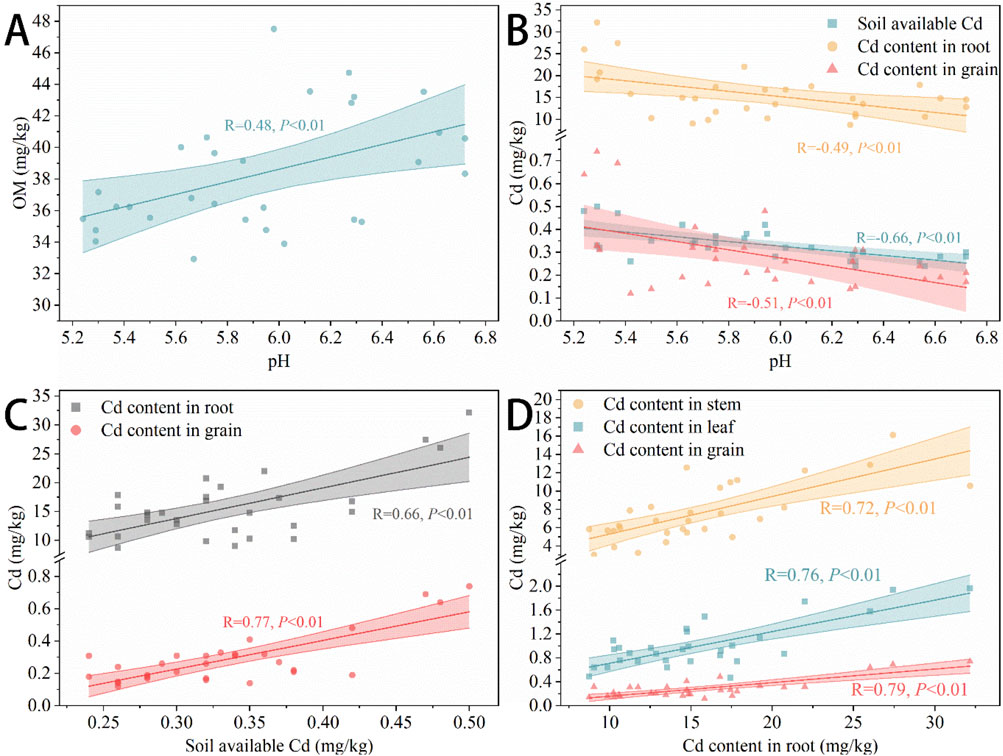
Figure 7. Correlation analysis of pH and OM (A), pH and soil available Cd, Cd content in root, Cd content in grain (B), soil available Cd and Cd content in root, Cd content in grain (C), Cd content in root and Cd content in stem, Cd content in leaf, Cd content in grain (D).
4 Discussion
Cd accumulation in rice grain is mainly due to soil Cd pollution. The process of Cd accumulation in grain from soil can be divided into four steps (Davidson et al., 1998; Yang et al., 2017): 1) Cd2+ transported from soil to the surface of rice root and absorbed by it; 2) Cd2+ translocated within rice root and loaded into the xylem; 3) Cd2+ transported and stored in the rice stem and leaf; 4) Cd in the rice stem and leaf is activated and re-transferred to rice grain. Therefore, controlling Cd pollution in rice grain involves preventing Cd absorption by rice from the soil and blocking its transportation within the rice plant. Red mud, silicon fertilizer, and phosphorus fertilizer have been proven to be promising materials for controlling Cd pollution in rice by reducing soil Cd availability and inhibiting Cd uptake and translocation in rice (Meng et al., 2022; Rehman et al., 2019; Zhao et al., 2020b). However, further study is needed to determine their effectiveness with different crops and in various regions, as well as the optimal application rates for controlling Cd pollution. In this study, we found that Cd content in rice decreased after application of the combined soil amendments, particularly in the content of rice root and grain, which were significantly lower than the CK. Furthermore, the Cd contents in the grain of C2 and C3 were found to be below the safety limit (0.20 mg/kg) of standard GB 2762-2022 (SAMR and SAPRC, 2022). This indicated that the Cd pollution of acidic, severely Cd-contaminated paddy fields could be controlled by applying the combined soil amendments. Because single applications of red mud, silicon fertilizer, and phosphorus fertilizer had been proved effective in moderately and mildly Cd-contaminated farmland for different crops and in various regions (Gray and Wise, 2020; Mamun et al., 2021; Xu et al., 2022), and numerous studies have confirmed that combined soil amendments are more effective than single soil amendments (Jiang et al., 2022; Zeng et al., 2023), we think the combined soil amendments screened in this study can be attempted to be applied to other crops and regions. Based on variance and range analysis, the optimal application rate for controlling Cd pollution in rice grain was found to be 1,800 kg/ha red mud, 600 kg/ha silicon fertilizer, and 675 kg/ha phosphorus fertilizer.
Many studies have confirmed that the mechanisms by which soil amendments control Cd pollution in rice primarily involve reducing the Cd availability in soil and inhibiting its uptake and translocation by rice plants (Lombi et al., 2002; Garau et al., 2007; Li et al., 2018). In this study, the decrease in soil-available Cd was detected after application of the combined soil amendments. Furthermore, the most significant positive correlation was found between soil-available Cd and the Cd content in both root and grain. This indicated that the reduction of Cd availability in soil was one of the mechanisms of the combined soil amendments. The effectiveness of red mud in reducing Cd availability in soil is not only attributed to its strong alkalinity (pH > 11), which increases soil pH, but also to its high content of Fe and Al oxides (such as Fe2O3 and Al2O3), large surface (Xue et al., 2020), and abundant surface hydroxyl groups. Studies have shown that in addition to physically adsorbing Cd2+ onto their surface, Fe and Al oxides and hydroxides can further form stable inner-sphere complexes with Cd2+, thereby reducing its availability in soil (Hua et al., 2017; Lombi et al., 2002; Garau et al., 2007). Silicon fertilizer can combine with available Cd to form a polysilicate gel Si-Cd complex (Ma et al., 2002; Liang et al., 2005). Phosphate fertilizer releases large amounts of PO43- into soil, which form Cd-P precipitates (Gupta et al., 2014; Ren et al., 2018). These processes also reduce Cd availability in the soil, thereby reducing Cd uptake by rice. At the rice uptake sites, due to the high content of divalent cations such as Ca2+, Mg2+, and Fe2+ in combined soil amendments, these cations can exchange with Cd2+ in rice root cell walls and compete with Cd2+ for transporter sites in rice (Ye et al., 2020). This competition interaction effectively inhibits absorption and transportation of Cd2+ in rice (Solti et al., 2011), ultimately resulting in decreased Cd content in rice. Additionally, silicon can form natural barriers, effectively preventing Cd2+ from penetrating the rice root cell wall (Ma et al., 2015; Wei et al., 2021). Thus, competition for absorption and transport channels with Cd2+ may be another mechanism by which the combined soil amendment functions and the reason for the most significant positive correlation between Cd content in the root and the Cd content in both stem and leaf.
Soil pH has been proven to be one of the most significant factors affecting Cd availability in soil (Yu et al., 2014). As soil pH increases, the availability of soil Cd diminishes correspondingly, thereby resulting in decreased absorption and accumulation of cadmium by rice plants (Li et al., 2018; Zhou et al., 2024). Therefore, alkaline substances are the most important components to control Cd pollution in rice. In this study, alkalinity was the most important reason for the effectiveness of the combined soil amendments. Because of its alkaline nature, soil pH increased significantly after application of the combined soil amendments, and the more combined soil amendments were added, the more soil pH increased. Due to higher pH, the effects of red mud on soil pH were found to be significantly higher than those of silicon fertilizer and phosphate fertilizer alone. Studies have shown that when the pH reaches a certain level (pH > 6.5), even if the soil Cd content exceeds the limit, the Cd content in grain remains below the limit (Römkens et al., 2009; Chen et al., 2021). Thus, increasing soil pH is a primary measure for mitigating Cd pollution in rice. However, excessively high soil pH can lead to soil salinity and alkalinity, which negatively affect rice growth (Jiang et al., 2023). Therefore, the quantity of alkaline substances must be rigorously regulated to prevent detrimental impacts when utilized as a soil amendment to control Cd pollution in rice.
Effectiveness and safety are key considerations for soil amendments. If soil amendments contain harmful components, they will bring secondary pollution into soils and plants, which in turn harm our health (Liu et al., 2025). Some researchers think that red mud, as an industrial waste byproduct, contains harmful components, rendering it unsuitable for remediation of Cd pollution in rice (Chao et al., 2022). However, in this study, total Cd contents in soil showed no significant changes, whereas Cd content in rice decreased after application of the combined soil amendments. This indicates that the addition of red mud did not lead to an increase in Cd pollution in either soil or rice. Moreover, our previous studies also confirmed that applying red mud did not lead to an increase in the content of heavy metals in either soil or rice. What is more, the results also showed that the contents of heavy metals in red mud used in this study were lower than the safe limit of standard GB 38400-2019 (SAMR and SAPRC, 2019). All results indicate that using red mud to remediate Cd pollution in rice is safe and effective. To ensure that red mud does not pose potential ecological risks to paddy fields and rice, its content of heavy metals must be measured before it is used.
Cost is also another crucial factor for the application of soil amendments to control cadmium pollution in rice grain (Fang et al., 2021). Total cost includes the cost of the soil amendment, transportation, and labor (Liu et al., 2025). In this study, based on the optimal rate of the combined soil amendments, the cost of the combined soil amendments and transportation was approximately 2,498 yuan/ha, and the labor cost was approximately 450 yuan/ha, resulting in a total cost of 2,948 yuan/ha. Notably, the total cost of our screened combined soil amendments was lower than that of many reported soil amendments (Liu et al., 2025). Compared with the CK, application of our screened combined soil amendments resulted in an increase in rice grain biomass by 195–1,595 kg/ha, which, at the price of 2.6 yuan/kg, translated to an income increase of 507–4,147 yuan/ha. Additionally, the Cd content in rice grain was reduced below the standard, leading to an increase in price by 0.4 yuan/kg and an additional profit of 2,448 yuan/ha. Overall, the total benefit of application of our screened combined soil amendments ranged from 2,955 to 6,595 yuan/ha, with a minimum benefit of 7 yuan/ha, which exceeds the total cost. This indicates that applying our screened combined soil amendments not only reduces the health effects of Cd pollution in rice grain but also generates economic benefits. All results showed that the combined soil amendments screened in this study were low cost, safe, and efficient soil amendments, worthy of being used on a large scale.
Although this study provides an effective soil remediation strategy for addressing Cd pollution, it still has certain limitations. First, the research was conducted under specific acidic soil conditions in Hunan Province, and the results may be influenced by regional climate, soil types, and crop varieties. Second, while the combination of soil amendments showed promising short-term effects, their long-term efficacy remains unclear. Future studies should focus on the impacts of these amendments on soil health, crop yield, and sustained cadmium control over time. Moreover, although the cost of soil amendments is relatively low, the actual cost and feasibility of large-scale application require further evaluation.
This study also aligns with the United Nations Sustainable Development Goals (SDGs), particularly SDG 2: Zero Hunger and SDG 12: Responsible Consumption and Production. By offering an effective solution for reducing Cd contamination in rice, a staple food for more than half of the global population, the research contributes to ensuring food safety and improving public health. Additionally, the use of low-cost, high-efficiency soil amendments in severely Cd-contaminated paddy fields has policy relevance for promoting sustainable agricultural practices, enhancing environmental protection, and strengthening food security strategies.
5 Conclusion
After applying the combined soil amendments, the Cd content in the edible part of rice can be reduced to below the safe limit. The safe production in acidic, severely Cd-contaminated paddy fields could be achieved by applying the combined soil amendments, providing a method for the remediation of severely Cd-contaminated paddy fields and a reference for global Cd-contaminated field remediation. Due to its low-cost, high efficiency, and simple operation, it can be promoted on a large scale for the remediation of Cd-contaminated paddy fields to achieve safe production.
Data availability statement
The original contributions presented in the study are included in the article/supplementary material; further inquiries can be directed to the corresponding author.
Author contributions
JY: writing – original draft and writing – review and editing. ZZ: data curation and writing – original draft. HY: funding acquisition and writing – original draft. JW: formal analysis and writing – original draft. ZY: software and writing – original draft. CF: validation and writing – original draft. XW: funding acquisition and writing – review and editing.
Funding
The author(s) declare that financial support was received for the research and/or publication of this article. This work was funded by the National Key Research and Development Project (No. 2017YFD0801505), the Science and Technology Program of Hunan Province (No. 2016NK2107), the Special Project of the Ministry of Agriculture and Finance of China (No. 2016263), and the Scientific Project of Department of Education of Hunan Province (No. 12B059).
Conflict of interest
The authors declare that the research was conducted in the absence of any commercial or financial relationships that could be construed as a potential conflict of interest.
Generative AI statement
The author(s) declare that no Generative AI was used in the creation of this manuscript.
Publisher’s note
All claims expressed in this article are solely those of the authors and do not necessarily represent those of their affiliated organizations, or those of the publisher, the editors and the reviewers. Any product that may be evaluated in this article, or claim that may be made by its manufacturer, is not guaranteed or endorsed by the publisher.
References
Bao, S. D. (2000). Soil agricultural chemical analysis. 3rd Edition. Beijing: China Agricultural Press.
Cai, Y., Zhang, S., Cai, K., Huang, F., Pan, B., and Wang, W. (2020). Cd accumulation, biomass and yield of rice are varied with silicon application at different growth phases under high concentration cadmium-contaminated soil. Chemosphere 242, 125128. doi:10.1016/j.chemosphere.2019.125128
Chao, X., Zhang, T., Lyu, G., Liang, Z., and Chen, Y. (2022). Sustainable application of sodium removal from red mud: cleaner production of silicon-potassium compound fertilizer. J. Clean. Prod. 352, 131601. doi:10.1016/j.jclepro.2022.131601
Chen, H. P., Wang, P., Chang, J. D., Kopittke, P. M., and Zhao, F. J. (2021). Producing cd-safe rice grains in moderately and seriously cd-contaminated paddy soils. Chemosphere 267, 128893. doi:10.1016/j.chemosphere.2020.128893
Davidson, C. M., Duncan, A. L., Littlejohn, D., Ure, A. M., and Garden, L. M. (1998). A critical evaluation of the three-stage BCR sequential extraction procedure to assess the potential mobility and toxicity of heavy metals in industrially-contaminated land. Anal. Chim. Acta 363, 45–55. doi:10.1016/S0003-2670(98)00057-9
Deng, X., Chen, Y., Yang, Y., Lu, L., Yuan, X., Zeng, H., et al. (2020). Cadmium accumulation in rice (Oryza sativa L.) alleviated by basal alkaline fertilizers followed by topdressing of manganese fertilizer. Environ. Pollut. 262, 114289. doi:10.1016/j.envpol.2020.114289
Fang, X., Wang, J., Chen, H., Christl, I., Wang, P., Kretzschmar, R., et al. (2021). Two-year and multi-site field trials to evaluate soil amendments for controlling cadmium accumulation in rice grain. Environ. Pollut. 289, 117918. doi:10.1016/j.envpol.2021.117918
Feng Shao, J., Che, J., Yamaji, N., Fang Shen, R., and Feng Ma, J. (2017). Silicon reduces cadmium accumulation by suppressing expression of transporter genes involved in cadmium uptake and translocation in rice. J. Exp. Bot. 68, 5641–5651. doi:10.1093/jxb/erx364
Fukagawa, N. K., and Ziska, L. H. (2019). Rice: importance for global nutrition. J. Nutr. Sci. Vitaminol. 65, S2–S3. doi:10.3177/jnsv.65.S2
Garau, G., Castaldi, P., Santona, L., Deiana, P., and Melis, P. (2007). Influence of red mud, zeolite and lime on heavy metal immobilization, culturable heterotrophic microbial populations and enzyme activities in a contaminated soil. Geoderma 142, 47–57. doi:10.1016/j.geoderma.2007.07.011
Gray, C. W., and Wise, B. E. (2020). Mitigating cadmium accumulation in spinach and onions by the application of silicon fertilizer to soil. Soil Sediment Contam. Int. J. 29, 532–544. doi:10.1080/15320383.2020.1747980
Guo, M., Tan, Y., Chen, D., Song, W., and Cao, S. (2022). Optimization and stability of the bottom structure parameters of the deep sublevel stope with delayed backfilling. Minerals 12, 709. doi:10.3390/min12060709
Gupta, D. K., Chatterjee, S., Datta, S., Veer, V., and Walther, C. (2014). Role of phosphate fertilizers in heavy metal uptake and detoxification of toxic metals. Chemosphere 108, 134–144. doi:10.1016/j.chemosphere.2014.01.030
Hua, Y., Heal, K. V., and Friesl-Hanl, W. (2017). The use of red mud as an immobiliser for metal/metalloid-contaminated soil: a review. J. Hazard. Mater. 325, 17–30. doi:10.1016/j.jhazmat.2016.11.073
Huang, Y., Yang, W., Li, Y., and Guo, W. (2022). Spatial distribution characteristics of plastic failure and grouting diffusion within deep roadway surrounding rock under three-dimensional unequal ground stress and its application. Minerals 12, 296. doi:10.3390/min12030296
Hussain, B., Lin, Q., Hamid, Y., Sanaullah, M., Di, L., Hashmi, M. L. U. R., et al. (2020). Foliage application of selenium and silicon nanoparticles alleviates Cd and Pb toxicity in rice (Oryza sativa L.). Sci. Total Environ. 712, 136497. doi:10.1016/j.scitotenv.2020.136497
Jiang, C. J., Liang, Z. W., and Xie, X. Z. (2023). Priming for saline-alkaline tolerance in rice: current knowledge and future challenges. Rice Sci. 30, 417–425. doi:10.1016/j.rsci.2023.05.003
Jiang, Y., Zhou, H., Gu, J.-F., Zeng, P., Liao, B.-H., Xie, Y.-H., et al. (2022). Combined amendment improves soil health and brown rice quality in paddy soils moderately and highly Co-contaminated with Cd and as. Environ. Pollut. 295, 118590. doi:10.1016/j.envpol.2021.118590
Li, H., Liu, Y., Zhou, Y., Zhang, J., Mao, Q., Yang, Y., et al. (2018). Effects of red mud based passivator on the transformation of Cd fraction in acidic Cd-polluted paddy soil and Cd absorption in rice. Sci. Total Environ. 640–641, 736–745. doi:10.1016/j.scitotenv.2018.05.327
Liang, Y., Wong, J. W. C., and Wei, L. (2005). Silicon-mediated enhancement of cadmium tolerance in maize (zea mays L.) grown in cadmium contaminated soil. Chemosphere 58, 475–483. doi:10.1016/j.chemosphere.2004.09.034
Liu, J., Xu, X., Meng, J., Li, Z., Wu, Y., Xu, L., et al. (2025). Three-year remediation evaluation for arsenic and cadmium co-contaminated acidic and alkaline paddy fields: insights on availability, bioaccumulation, health risk, and cost. J. Environ. Chem. Eng. 13, 116054. doi:10.1016/j.jece.2025.116054
Lombi, E., Zhao, F.-J., Zhang, G., Sun, B., Fitz, W., Zhang, H., et al. (2002). In situ fixation of metals in soils using bauxite residue: chemical assessment. Environ. Pollut. 118, 435–443. doi:10.1016/S0269-7491(01)00294-9
Ma, J., Cai, H., He, C., Zhang, W., and Wang, L. (2015). A hemicellulose-bound form of silicon inhibits cadmium ion uptake in rice (Oryza sativa) cells. New Phytol. 206, 1063–1074. doi:10.1111/nph.13276
Ma, J. F., Tamai, K., Ichii, M., and Wu, G. F. (2002). A Rice Mutant Defective in Si Uptake. Plant Physiol. 130, 2111–2117. doi:10.1104/pp.010348
Mamun, S. A., Sultana, N., Hasan, M., Latif, M. B., Islam, A., and Tusher, T. R. (2021). Phytoaccumulation of cadmium in leafy vegetables grown in contaminated soil under varying rates of compost and phosphate fertilizer application. Commun. Soil Sci. Plant Analysis 52, 2161–2176. doi:10.1080/00103624.2021.1921187
Mao, Y., Tan, H., Wang, M., Jiang, T., Wei, H., Xu, W., et al. (2022). Research progress of soil microorganisms in response to heavy metals in rice. J. Agric. Food Chem. 70, 8513–8522. doi:10.1021/acs.jafc.2c01437
MEEPRC and SAMR (2018). Soil environmental quality - risk control standard for soil contamination of agricultural land (GB 15618-2018)
Meng, X., Yang, J., Zheng, G., and Xia, T. (2022). Effects of red mud on cadmium uptake and accumulation by rice and chemical changes in rhizospheres by rhizobox method. Minerals 12, 929. doi:10.3390/min12080929
Nawaz, A., Rehman, A. U., Rehman, A., Ahmad, S., Siddique, K. H. M., and Farooq, M. (2022). Increasing sustainability for rice production systems. J. Cereal Sci. 103, 103400. doi:10.1016/j.jcs.2021.103400
Pei, P., Xu, Y., Zheng, S., Liang, X., Sun, Y., Lin, D., et al. (2021). The use of bentonite and organic amendments for remediation of Cd contaminated fields: an environmental perspective. Land Degrad. Dev. 32, 3639–3652. doi:10.1002/ldr.3797
Rehman, M. Z. U., Rizwan, M., Rauf, A., Ayub, M. A., Ali, S., Qayyum, M. F., et al. (2019). Split application of silicon in cadmium (cd) spiked alkaline soil plays a vital role in decreasing Cd accumulation in rice (Oryza sativa L.) grains. Chemosphere 226, 454–462. doi:10.1016/j.chemosphere.2019.03.182
Ren, J., Zhang, Z., Wang, M., Guo, G., Du, P., and Li, F. (2018). Phosphate-induced differences in stabilization efficiency for soils contaminated with lead, zinc, and cadmium. Front. Environ. Sci. and Eng. 12, 10. doi:10.1007/s11783-018-1006-2
Römkens, P. F. A. M., Guo, H. Y., Chu, C. L., Liu, T. S., Chiang, C. F., and Koopmans, G. F. (2009). Prediction of cadmium uptake by brown rice and derivation of soil–plant transfer models to improve soil protection guidelines. Environ. Pollut. 157, 2435–2444. doi:10.1016/j.envpol.2009.03.009
SAMR and SAPRC (2019). Limitation requirements of toxic and harmful substance in fertilizers (GB 38400-2019).
SAMR and SAPRC (2022). National food safety standard – maximum levels of contaminants in foods (GB 2762-2022)
Seshadri, B., Bolan, N. S., Choppala, G., Kunhikrishnan, A., Sanderson, P., Wang, H., et al. (2017). Potential value of phosphate compounds in enhancing immobilization and reducing bioavailability of mixed heavy metal contaminants in shooting range soil. Chemosphere 184, 197–206. doi:10.1016/j.chemosphere.2017.05.172
Seshadri, B., Bolan, N. S., Wijesekara, H., Kunhikrishnan, A., Thangarajan, R., Qi, F., et al. (2016). Phosphorus–cadmium interactions in paddy soils. Geoderma 270, 43–59. doi:10.1016/j.geoderma.2015.11.029
Solti, Á., Sárvári, É., Tóth, B., Basa, B., Lévai, L., and Fodor, F. (2011). Cd affects the translocation of some metals either Fe-like or Ca-like way in poplar. Plant Physiol. biochem. 49, 494–498. doi:10.1016/j.plaphy.2011.01.011
Song, W.-Y., Ju Sohn, E., Martinoia, E., Jik Lee, Y., Yang, Y.-Y., Jasinski, M., et al. (2003). Engineering tolerance and accumulation of lead and cadmium in transgenic plants. Nat. Biotechnol. 21, 914–919. doi:10.1038/nbt850
Tang, L., Risalat, H., Cao, R., Hu, Q., Pan, X., Hu, Y., et al. (2022). Food security in China: a brief view of rice production in recent 20 years. Foods 11, 3324. doi:10.3390/foods11213324
Wang, P., Chen, H., Kopittke, P. M., and Zhao, F.-J. (2019). Cadmium contamination in agricultural soils of China and the impact on food safety. Environ. Pollut. 249, 1038–1048. doi:10.1016/j.envpol.2019.03.063
Wang, S., Jin, H., Deng, Y., and Xiao, Y. (2021). Comprehensive utilization status of red mud in China: a critical review. J. Clean. Prod. 289, 125136. doi:10.1016/j.jclepro.2020.125136
Wei, W., Peng, H., Xie, Y., Wang, X., Huang, R., Chen, H., et al. (2021). The role of silicon in cadmium alleviation by rice root cell wall retention and vacuole compartmentalization under different durations of Cd exposure. Ecotoxicol. Environ. Saf. 226, 112810. doi:10.1016/j.ecoenv.2021.112810
Wu, J., Song, Q., Wu, Y., Liu, J., Wu, Z., Zhou, J., et al. (2023). Application of phosphorus amendments reduces metal uptake and increases yield of oryza saliva L. (rice) in Cd/cu-Contaminated paddy field. Chemosphere 318, 137875. doi:10.1016/j.chemosphere.2023.137875
Xiao, Z., Peng, M., Mei, Y., Tan, L., and Liang, Y. (2021). Effect of organosilicone and mineral silicon fertilizers on chemical forms of cadmium and lead in soil and their accumulation in rice. Environ. Pollut. 283, 117107. doi:10.1016/j.envpol.2021.117107
Xu, Z., Lu, Z., Zhang, L., Fan, H., Wang, Y., Li, J., et al. (2021). Red mud based passivator reduced Cd accumulation in edible amaranth by influencing root organic matter metabolism and soil aggregate distribution. Environ. Pollut. 275, 116543. doi:10.1016/j.envpol.2021.116543
Xu, Z. M., Zhang, Y. X., Wang, L., Liu, C. G., Sun, W. M., Wang, Y. F., et al. (2022). Rhizobacteria communities reshaped by red mud based passivators is vital for reducing soil Cd accumulation in edible amaranth. Sci. Total Environ. 826, 154002. doi:10.1016/j.scitotenv.2022.154002
Xue, S., Ke, W., Zhu, F., Ye, Y., Liu, Z., Fan, J., et al. (2020). Effect of phosphogypsum and poultry manure on aggregate-associated alkaline characteristics in bauxite residue. J. Environ. Manage. 256, 109981. doi:10.1016/j.jenvman.2019.109981
Yang, J., Wang, C., and Dai, H. (2008). Soil agrochemical analysis and environmental monitoring. Beijing: China Earth Press.
Yang, Y., Zhou, X., Tie, B., Peng, L., Li, H., Wang, K., et al. (2017). Comparison of three types of oil crop rotation systems for effective use and remediation of heavy metal contaminated agricultural soil. Chemosphere 188, 148–156. doi:10.1016/j.chemosphere.2017.08.140
Ye, W., Wu, F., Zhang, G., Fang, Q., Lu, H., and Hu, H. (2020). Calcium decreases cadmium concentration in root but facilitates cadmium translocation from root to shoot in rice. J. Plant Growth Regul. 39, 422–429. doi:10.1007/s00344-019-09992-z
Yu, E., Wang, W., Yamaji, N., Fukuoka, S., Che, J., Ueno, D., et al. (2022). Duplication of a manganese/cadmium transporter gene reduces cadmium accumulation in rice grain. Nat. Food 3, 597–607. doi:10.1038/s43016-022-00569-w
Yu, L., Zhu, J., Huang, Q., Su, D., Jiang, R., and Li, H. (2014). Application of a rotation system to oilseed rape and rice fields in Cd-contaminated agricultural land to ensure food safety. Ecotoxicol. Environ. Saf. 108, 287–293. doi:10.1016/j.ecoenv.2014.07.019
Zeng, P., Liu, J., Zhou, H., Wei, B., Gu, J., Liao, Y., et al. (2023). Co-application of combined amendment (limestone and sepiolite) and Si fertilizer reduces rice Cd uptake and transport through Cd immobilization and Si–Cd antagonism. Chemosphere 316, 137859. doi:10.1016/j.chemosphere.2023.137859
Zhao, D., Juhasz, A. L., Luo, J., Huang, L., Luo, X.-S., Li, H.-B., et al. (2017a). Mineral dietary supplement to decrease cadmium relative bioavailability in rice based on a mouse bioassay. Environ. Sci. Technol. 51, 12123–12130. doi:10.1021/acs.est.7b02993
Zhao, D., Liu, R., Xiang, P., Juhasz, A. L., Huang, L., Luo, J., et al. (2017b). Applying cadmium relative bioavailability to assess dietary intake from rice to predict cadmium urinary excretion in nonsmokers. Environ. Sci. Technol. 51, 6756–6764. doi:10.1021/acs.est.7b00940
Zhao, F. J., Ma, Y., Zhu, Y.-G., Tang, Z., and McGrath, S. P. (2015). Soil contamination in China: current status and mitigation strategies. Environ. Sci. Technol. 49, 750–759. doi:10.1021/es5047099
Zhao, Y., Liu, M., Guo, L., Yang, D., He, N., Ying, B., et al. (2020a). Influence of silicon on cadmium availability and cadmium uptake by rice in acid and alkaline paddy soils. J. Soils Sediments 20, 2343–2353. doi:10.1007/s11368-020-02597-0
Zhao, Y., Zhang, C., Wang, C., Huang, Y., and Liu, Z. (2020b). Increasing phosphate inhibits cadmium uptake in plants and promotes synthesis of amino acids in grains of rice. Environ. Pollut. 257, 113496. doi:10.1016/j.envpol.2019.113496
Zhong, S., Li, X., Li, F., Liu, T., Huang, F., Yin, H., et al. (2021). Water management alters cadmium isotope fractionation between shoots and nodes/leaves in a soil-rice system. Environ. Sci. Technol. 55, 12902–12913. doi:10.1021/acs.est.0c04713
Zhou, Y., Cui, Y., Yang, J., Chen, L., Qi, J., Zhang, L., et al. (2024). Roles of red mud in remediation of contaminated soil in mining areas: mechanisms, advances and perspectives. J. Environ. Manag. 356, 120608. doi:10.1016/j.jenvman.2024.120608
Zhu, D., Wang, J., Gong, W., and Sun, Z. (2020). Model test and numerical study on surrounding rock deformation and overburden strata movement law of gob-side entry retaining via roof cutting. Minerals 10, 458. doi:10.3390/min10050458
Keywords: soil, Cd contamination, combined soil amendments, rice, pollution control
Citation: Yang J, Zou Z, Yang H, Wu J, Yang Z, Fang C and Wei X (2025) Effects of combined soil amendments on the availability and migration of Cd in soil and rice. Front. Environ. Sci. 13:1548784. doi: 10.3389/fenvs.2025.1548784
Received: 20 December 2024; Accepted: 24 June 2025;
Published: 16 July 2025.
Edited by:
Mariusz Gusiatin, University of Warmia and Mazury in Olsztyn, PolandReviewed by:
Xiaoping Xin, University of Missouri, United StatesNnanake-Abasi O. Offiong, Topfaith University, Nigeria
V. N. Meena Devi, Noorul Islam University, India
Copyright © 2025 Yang, Zou, Yang, Wu, Yang, Fang and Wei. This is an open-access article distributed under the terms of the Creative Commons Attribution License (CC BY). The use, distribution or reproduction in other forums is permitted, provided the original author(s) and the copyright owner(s) are credited and that the original publication in this journal is cited, in accordance with accepted academic practice. No use, distribution or reproduction is permitted which does not comply with these terms.
*Correspondence: Xiangdong Wei, eGlhbmdkb25nd0BodW5hdS5lZHUuY24=
 Jie Yang
Jie Yang Zhu Zou1
Zhu Zou1
